Annapurna & Machhapuchre Base Camp Trek 09 Days
(Fantastic Experience in the Glacier)
(Fantastic Experience in the Glacier)
 This 10 days around the spectacular Annapurna region brings you through scenic village, rich oak, pine and rhododendron forest. In the route, you will be overwhelmed by the close-up views of the giant snow peaks- Annapurna I (8091m) and Mt. Machhapuchhre (6993m.) just above your head as if you can touch within a volleyball jump. This trekking reccomended for excellent mountain vistas. The central region of Annapurna Base camp boasts some of the most brilliant sunset in Nepal. This is the most popular trekking area in Nepal.
This 10 days around the spectacular Annapurna region brings you through scenic village, rich oak, pine and rhododendron forest. In the route, you will be overwhelmed by the close-up views of the giant snow peaks- Annapurna I (8091m) and Mt. Machhapuchhre (6993m.) just above your head as if you can touch within a volleyball jump. This trekking reccomended for excellent mountain vistas. The central region of Annapurna Base camp boasts some of the most brilliant sunset in Nepal. This is the most popular trekking area in Nepal.Day | Place | Program / Schedule | 3 Meals |
| 01. | Pokhara | Apt Pick up , hotel check in, refreshment and preparation for the trekking (enjoy evening with Nepali or Japanese set food) | Pension |
| 02 | Ghandruk | Drive to Nayapul and climb up to Ghandruk, typical gurung village, Beautiful view of Annapurna South and Mt fishtail (5 hrs walk) | Lodge |
| 03 | Chomrong | After breakfast departure to Chomrong, average walk 5 hour (one can go through Jhinu hotspring but little bit ascend) 1 hour extra walk | Lodge |
| 04 | Dhobhan | We walkl through mountain valley and have to cross glacier path in winter (Altitude 2600m) Note:Donkey are not allowed from Sinwa | Lodge |
| 05 | MBC | This is the tuff part , we reach MBC after 7 hours long walk. (Altitude: 3700m) Note: Firewood and Meat items not allowed from Deurali | Lodge |
| 06 | Himalaya | Early morning go up to ABC Annapurna Base camp and enjoy glacier, walk down to MBC and again back to Himalaya (slowly 7 hours walk) | Lodge |
| 07 | Jhinu | Enjoy hot spring at Jhinu (25 minute walk down to river side from Jhinu) , (altitude 1780) Eight hours walk | Lodge |
| 08 | Pothana | We shall have Lunch at Landruk, typical gurung village and beauriful mountain view of Annapurna south and Himchuli and 6 hrs walk to Pothana | Lodge |
| 09 | Pokhara | After enjoying FISH TAIL and annapurna range view we walk down to Phedi through Dhampus. Enjoy Hot bath and Japanes food tonight | Pension |
| 10 | Kathmandu | Early morning Pokhara city sightseeing and fly to KTM at 12noon again KTM city sightseeing (Pashupatinath, Darbar square , Swyambhunath) | Hotel |
TREK COST : 855 USD (Per Person). (Group Above 5 Pax 760 USD / Person)
COST INCLUDES : Guide, Porter, 3 meals, accommodation, entrance fees, needed basic trekking equipments & Map, transportation, air ticket to Pokhara.
COST EXCLUDES: Insurance, Beverage, Shopping, Helicopter Rescue, Tips
DEPARTURE DATE : Every Day
DAY RETURN HOT SPRING TOUR IN POKHARA
(Far from the madding crowd)
....Imagine a gentle countryside drive through, typical Chettri village, saplings and terraces, wild nature, pieces of clouds fluttering in the blue- mere blue sky and full blooming red- Rhododendron and snow peaks on the background. Isn't it a beautiful? Nobody knows more about delighting the senses than to melt the self amidst the beauty of loneliness. It needs no words to speak with nature. You can just stare and smile, be closer and enjoy the pleasure of being a part of the nature. Who does not want to be in the plinth of Virgin Mt. Fishtail and dip into 41 degree natural hot spring. Speciality of this tour
 |  |
- The real Nepalese lifestyle- Comletely countryside tour / trek where we can enjoy beautiful skyfull of stars in the naked sky very close.
- Natural hot spring bath (good for, body ache, skin diseases, rheumatism etc.)
- Day return Hike / Bicycle/ Motorcycle, Car Driving tour
- Only Organic and local products are available on the way.
- Beautiful landscape, wild herb garden, rich in vegetation, flora and fauna.
- Nepal’s National bird Lophophorous, National flower Rhododendron and wild animals viz. tiger, bear, leopard can be seen on the way.
- Good opportunity to watch wild honey hunter‘s honey harvest (challenging task- hanging at 600 / 700 high cliff just with the help of rope.
Tour Costs: USD 55 / Pax (Includes: Transportation, taxes, Guide & Lunch box)
Time Duration 7 am to 5pm (1.5hrs Drive/ 1 hrs Walk) Village walk / Hot Bath.
Time Duration 7 am to 5pm (1.5hrs Drive/ 1 hrs Walk) Village walk / Hot Bath.
LUMBINI (The Birthplace of Lord Buddha)
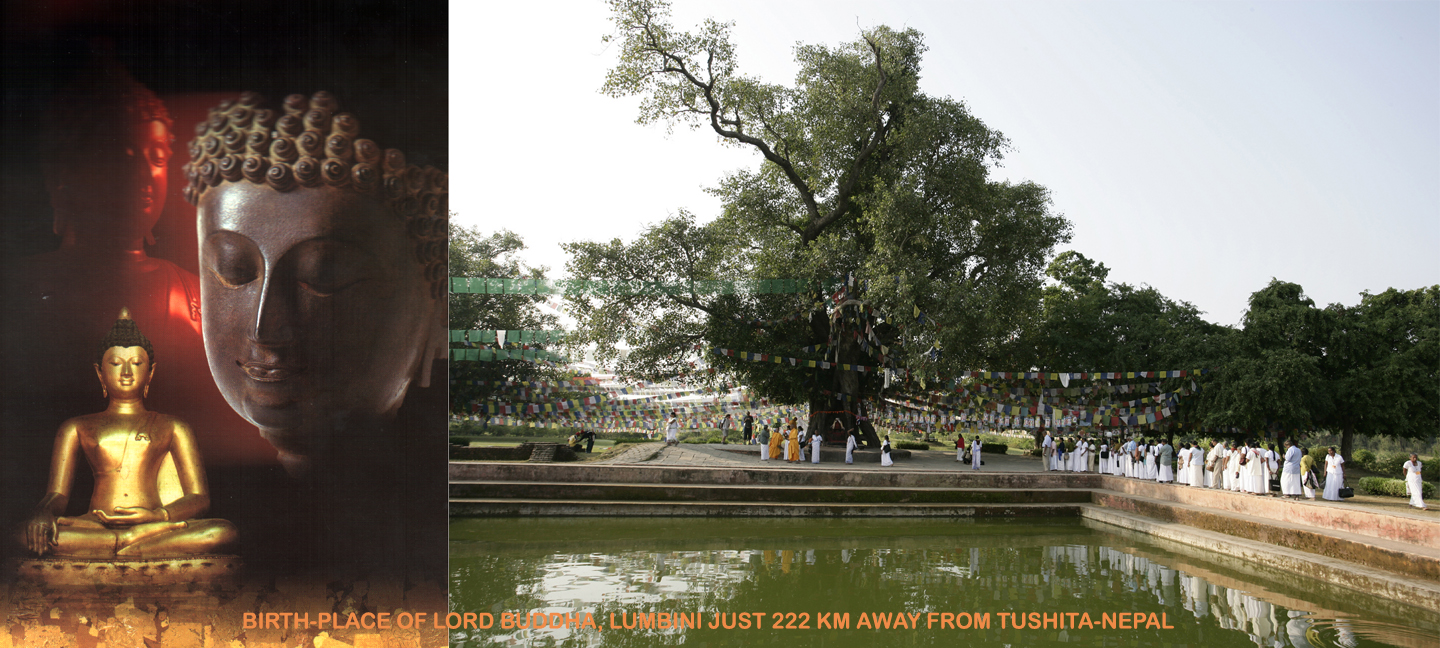 Lumbini, the birth place of Siddhartha Gautam, the shakya prince and the ultimate Buddha, the enlightened one, is the pilgrimage destination of the world's millions of Buddhists. UNESCO lists the nativity site and the Ashoka's pillar as a world heritage site. Mayadevi temple, sacred garden and the sacred pond (where queen Mayadevi had taken bath just before giving birth to the Buddha) are the major attractions of Lumbini. It is approximately 280 k.m from Kathmandu.
Lumbini, the birth place of Siddhartha Gautam, the shakya prince and the ultimate Buddha, the enlightened one, is the pilgrimage destination of the world's millions of Buddhists. UNESCO lists the nativity site and the Ashoka's pillar as a world heritage site. Mayadevi temple, sacred garden and the sacred pond (where queen Mayadevi had taken bath just before giving birth to the Buddha) are the major attractions of Lumbini. It is approximately 280 k.m from Kathmandu. Buddhist Pilgrimage Tour 14 Days
|
- PROGRAM SHEDULE CAN BE CHANGED ACCORDING TO YOUR DESIRE
- COST DEPENDS ON GRADE OF SERVICE IN HOTEL/ RESTAURANT/ TXF
- JUST LET US KNOW ABOUT YOUR INTEREST WE MAKE YOUR ITINERY
Himalayan High: A visit to Namche Bazaar
One of the most famous and popular stops on the way to Everest is a village called Namche Bazaar, which is located at 11,286 feet (3440 meters). Most trekkers reach Namche on their second day of hiking, but to get there they must first conquer a very long, and challenging hill that is a test of stamina for just about anyone. In fact, that day on the trail is one of the most challenging of the entire trek, as you gain more than 2600 feet (800 meters) in altitude. Fortunately, nearly everyone who makes the trek ends up spending an extra day in Namche, giving them a chance to rest, acclimatize, and explore the place further.Nestled along the crescent shaped slopes of the Khumbu Valley, Namche Bazaar is both charming and exhausting all at the same time. The narrow alleyways are lined with gear shops and teahouses, but you'll have to climb more steps than you'd care to count just to visit any of them. It is especially disheartening when you arrive in the village after 3 or 4 hours of climbing, only to to discover that the lodge that you're staying in happens to be on one of the upper tiers, and you'll have to climb yet more stairs just to get to it. Luckily, Namche has some of the most comfortable and inviting teahouses in the entire region. You might even get a warm shower (for an extra charge!) and a TV in the common room.

 That population in Namche swells dramatically during the spring and fall trekking seasons of course, with backpackers and climbers flocking to the area in droves. It is not uncommon to hear a half dozen languages being spoken while you stroll the cobblestone streets past the numerous gear shops, and if there is anything that Namche has an abundance of, it is gear shops. If you're a few days into the trek, and you find you're in need of some piece of gear, then chances are you can find it in Namche Bazaar. Whether it's boots, sleeping bags, or warmer clothes, you'll find everything you could possibly need, often at excellent prices. Some of the gear is authentic, some are cheap knockoffs, but the village is an outdoor gear lovers dream come true, and while it is possible to resupply on some items later in the trek, everything gets more expensive the higher you go.
That population in Namche swells dramatically during the spring and fall trekking seasons of course, with backpackers and climbers flocking to the area in droves. It is not uncommon to hear a half dozen languages being spoken while you stroll the cobblestone streets past the numerous gear shops, and if there is anything that Namche has an abundance of, it is gear shops. If you're a few days into the trek, and you find you're in need of some piece of gear, then chances are you can find it in Namche Bazaar. Whether it's boots, sleeping bags, or warmer clothes, you'll find everything you could possibly need, often at excellent prices. Some of the gear is authentic, some are cheap knockoffs, but the village is an outdoor gear lovers dream come true, and while it is possible to resupply on some items later in the trek, everything gets more expensive the higher you go. As I mentioned, you'll actually spend a "rest day" in Namche to help you get use to the altitude and give you time for a bit of recovery. But that doesn't mean that you'll be taking it easy while you're there. In fact, on my second day in Namche, my trekking group was up bright and early, as usual, and after breakfast we were on our way up a nearby mountain to continue working on our acclimatization. On that morning climb we actually went up an additional 1300 feet (400 meters), and got our first views of Everest, Lhotse, and one of the most beautiful mountains on the planet, Ama Dablam.
With our acclimatization climb out of the way, we were back in Namche by lunch time, and had the rest of the afternoon to spend at our leisure. Most of us took it easy, taking a nap, curling up with a good book, or playing cards in the lodge's common room. Namche is the first part of the trek where altitude sickness begins to become a real concern, and it is important that you not only work on acclimatizing, but also get plenty of rest. You're also burning a lot of calories on the trek and expending a lot of energy, therefore you'll spend your rest days eating plenty of food and drinking lots of water as well.
Before long, your stay in Namche is over, and you're back on the trail to ever higher, and ever smaller, villages. Each has their own unique character and each brings you one step closer to your ultimate goal - Everest. But when you depart Namche, you truly feel like you're stepping into the High Himalaya and moving into more remote territory. The first few days are just a warm up for the adventure that is just ahead.

Muktinath : This Sanskrit name itself has religious overtone and a sort of emotional ring to it for the devout Hindus. The name is synthesis of two words - Mukti and Nath. Mukti means Salvation or Nirvana and Nath mean god or Master. Mukti Holds grate significance for all spiritual people in the south Asian sub continent. Muktinath (the provider of salvation) has been one such holy site, where thousands of devotees flock for attaining the much sought after moksha (Freedom) from the cycle of birth and rebirth. It is an ardent wish or a dream if you may say, of every Hindu to get Mukti-Nirvana from this cycle taking births over and over again. It is belief of the Hindus that this world is "MAYA" (an illusion) and the earliest one gets out of it the better and a visit to Muktinath will help them achieve that goal. Since then it called Muktinath.
Muktinath is an important pilgrimage place for both Hindu & Buddhist. The holy shrine at Muktinath is in a grove of trees and includes a Buddhist Gompa and the pagoda style temple of Vishnu Temple, Containing an Image of Vishnu.
A Cluster of Temples and Palaces
 Listed as one of the eight Cultural World Heritage site by UNESCO, Kathmandu Durbar Square is a cluster of ancient temples, palaces, courtyards and streets that date back to the 12th and 18th centuries. The square is known to be the social, religious and urban focal point of the Capital City.
Listed as one of the eight Cultural World Heritage site by UNESCO, Kathmandu Durbar Square is a cluster of ancient temples, palaces, courtyards and streets that date back to the 12th and 18th centuries. The square is known to be the social, religious and urban focal point of the Capital City.The Palace Complex was the royal Nepalese residence until the 19th century and is the site of important ceremonies, such as the coronation of the Nepalese monarch. The palace is decorated with elaborately-carved wooden windows and panels an. It houses the King Tribhuwan Memorial Museum and the Mahendra Museum.
Fast Facts
| Location | Kathmandu |
| Significance | UNESCO World Heritage Site |
| UNESCO Category | Cultural |
| Built In | 16th and 17th centuries |
| Major Attractions | Taleju Temple and Hanuman Dhoka |
Major Attractions
Taleju Temple
The temple is a famous Hindu and Jain religious site. The three-tiered temple is the first to be erected with more than two roofs and raised on a tall stepped platform. It is said that the mandir was built in the shape of a yantra on the advice of the Taleju Goddess herself and that she appeared to the King at the dedication ceremony disguised as a bee.
Mahendreshvara Temple
The simple yet beautiful temple was built by King Mahendra Malla and is dedicated to the Hindu Lord Shiva in the form of Pashupati. The temple was destroyed in a 1934 earthquake and rebuilt thereafter. The temple is a memorial to its founder.
Jagannath Temple
The Jagannath Temple is recognized as the finest of the group near Hanuman Dhoka. Exquisite wood-carvings embellish the doors, windows and roof struts, depicting a panoply of gods from the Hindu pantheon. Originally dedicated to Vishnu the shrine was later re-dedicated to Jagannath.
Dequtale Temple
The temple was built by Shivasimha Malla honoring the Mallas' family deity, Degutale. It resembles Taleju's shrine but with a tower-like base in place of the stepped platform. The worship of Degutale has its origins in a nature cult, the images being pieces of rock which the Newaris set up and worshipped.
Hanuman Dhoka
Palace facade turns at right angles between the Degutale Temple and the Taleju Mandir. This way is created Hanuman Dhoka (Hanuman is a monkey god). Hanuman idol placed in the dhoka has been anointed with mustard oil and vermilion through the centuries.
Nasal Chowk
Nasal Chowk takes its name from the little statue of the dancing Krishna in the shrine on the east side of the court. In Malla times the podium in the center of the court was used for dancing displays. The Shah kings chose to be crowned in Nasal Chowk, a tradition which continues today.
Mul Chowk
As the occasional abode of the goddess Taleju, the court is barred to visitors, though it is often possible to peep in through the gate and have a look at the exquisite beauty of the palace. The Chowk is opened to Hindus once a year when, on the ninth day of the Dasain Festival, hundreds of buffaloes and goats are sacrificed to the goddess.
Bhandarkal
Bhandarkal is a botanical garden created by King Pratap Mall in the mid 17th century. With its diverse flora, Bhandarkal is a treat for nature lovers and ecologists. The garden has been named after a seven-storied palace that possesses a statue of the Sleeping Vishnu, Jalashayana Narayan.
Vilar Temple
Between the Lalitpur and Basantpur Towers can be seen the magnificently carved façade of the three-storied Vilas Mandir, of a richness truly befitting a Temple of Luxury.
Trailokya Mohan Narayan Temple
The three storied temple has the figure of Garuda placed in its front and incarnations of Lord Vishnu within the temple. It was built by Prithvi Bendra Malla in 1680.
Shiva Temple
The Shiva Temple in Darbar Square is a replica of the Jaisi Deval and was built by Riddhi Lakshmi in 1690.
Shiv Parvati Temple
The long low building on the northern side of Durbar Square contains the beautiful shrines of Shiva and Parvati. This somewhat unusual building is believed to date from the time of Bahadur Shah. It is probably a reconstruction, the stepped platform on which it stands being considerably older than the temple itself.
Manju Deval
Dedicated to Shiva the large three-storied Manju Deval on its unusually high stepped base seems to dominate Durbar Square. It was built in 1692 by the mother of Bhupatindra Malla of Bhaktapur. Inside the temple there is a Shiva lingam. The small shikhara (temple tower in the North Indian style) at the foot of the steps honors Kam Dev, Shiva's shakti.
Kumari Bahal
The house of the Living Goddess, the Kumari Bahal looks like the monastery that was constructed in 1757 by Jaya Prakash Malla. Inside it lives the young girl who is selected to be the town's living goddess, until she reaches her first puberty and reverts to being a normal mortal.
Kasthamandapa
Kasthamandap or house of wood is the building which gave Kathmandu its name. Legend narrates that the whole building is constructed from a Single Sal tree. At first it was a community hall where local people gathered for important ceremonies but later it was converted to a Temple of Gorakhnath. The image of Gorakhnath glitters at the center of the building.
Ashok Binayak Shrine
The Ashok Binayak Shrine is the principle shrine of Lord Ganesha in the Kathmandu Valley. The stone image of Lord Ganesha stands beneath a golden replica of the Ashok tree which once shaded the shrine and eventually gave it its name.
Simha Sattal
Simla Sattal is located at the southern end of the Kathmandu Durbar Square. The residential style temple contains the Garuda Narayan figure, strange looking effigies and a little shrine of Harikrishna.
 The political, commercial and cultural hub of Nepal is the first stop for the majority of visitors to the country. Once a separate kingdom in itself, it contains three fabled cities - Kathmandu, Patan and Bhaktapur. Out of ten UNESCO World Heritage Sites, seven cultural heritage sites are in Kathmandu Valley.
The political, commercial and cultural hub of Nepal is the first stop for the majority of visitors to the country. Once a separate kingdom in itself, it contains three fabled cities - Kathmandu, Patan and Bhaktapur. Out of ten UNESCO World Heritage Sites, seven cultural heritage sites are in Kathmandu Valley.The history of the Valley begins with the Buddhist saint Manjushree who slashed a passage through the surrounding hills to drain out the primordial waters and make it inhabitable. Over the centuries, a refined urban civilization emerged, built on a unique synthesis of Hinduism and Buddhism.
Dynasties came and went. Trade and the arts flourished. Its deeply religious Newar inhabitants built fabulous cities and artistic temples that attracted devout pilgrims as well as rampaging invaders. In the late 18th century, following the founding of modern Nepal within more or less the present boundaries, Kathmandu was made the capital. Kathmandu, the largest city in Nepal is situated at an altitude of 1,350m.
KATHMANDU (population 1,096,865 - 2001 census)
Durbar Square. This complex of palaces, courtyards and temples like Hanumandhoka Palace, Kumari Ghar (Abode of the Living Goddess), Taleju temple, built between the 12th and 18th centuries, used to be the seat of the ancient Malla Kings of Kathmandu. An intriguing piece here is the 17h -century stone inscription set into the wall of the palace with writings in 15 languages. The Durbar Square, protected as a UNESCO World Heritage Site, is the social, religious and urban focal point of the city. Even to date, all the major state and social ceremonies, including the solemnization of coronations are performed in one of the courtyards in this complex. There are also museums inside the palace building. There is an entrance fee of Rs. 250 for foreign visitors. Your ticket to the Square entitles you to visit all the museums.
Walkabout. A colorful and enlightening walk that gives you a feel of Kathmandu starts at Rani Pokhari, the large pond at Jamal beside the clock tower (Ghanta Ghar). The first stretch of the diagonal street leading southwest from here is called Kamalachhi. It is lined with bicycles and garment stores and brings you to the stone-paved market square of Ason, where the Annapurna temple presides over the motley of spice, grain and oil shops. Keep on walking and you come to Kel Tole after passing shops overflowing with brass utensils. Further on is the junction of Indrachowk with the temple of Akash Bhairav occupying one side. Your next stop after threading your way through the street lined with cloth shops is the stone-paved plaza of Makhan, where the Taleju temple towers over a row of handicraft shops. Walk on through Durbar Square to the intersection of Maru where you are surrounded by temples of all shapes and sizes.
Heritage Walk. A walk through selected historic sites seldom visited. This revitalizing walk starts at Teku, south of old Kathmandu, leading on to Wonder Narayan, a 17th century temple dedicated to Lord Bishnu. Strolling through Hyumat Tole, you will arrive at Kusah Bahi, a Buddhist courtyard built in 1754. The next stop is the Narayan Dewal, another Bishnu temple (built in 1865) with a small Ganesh temple at the entrance. Walk on to Tukan Baha, built in the 14th century as a replica of the Swayambhu stupa. Admire the Ram temple at the Ramchandra Dewal before reaching Jaisi Dewal, a huge Shiva temple built in 1688. Saunter down to Kohiti to study the Buddhist and Hindu sculptures in this sunken water fountain. Walk through Chikan Mugal and stop by at the Atko Narayan Dewal, an important Bishnu temple built in 1857, before visiting the namesake of the city, the Kasthamandap pavilion. After a further five-minute walk, reach the final destination, the Bhimsen Dewal, built in 1655 and dedicated to the main deity of local traders.
Swayambhu Stupa watches over the Valley from the top of a hillock on its western side just three kilometers west of the city center. The stupa is one of the holiest Buddhist sites in Nepal and its establishment is linked to the creation of the Kathmandu Valley out of a primordial lake. Swayambhu is also known as Samhengu and is listed as a World Heritage Site. It is also one of the oldest and glorious Buddhist shrines in the world which is said to be two thousand years. The four sides of the stupa is painted with the eyes of Lord Buddha and the temple is also known as the watchful eyes of Buddha. Entrance fee Rs. 50 (SAARC nationals Rs. 30).
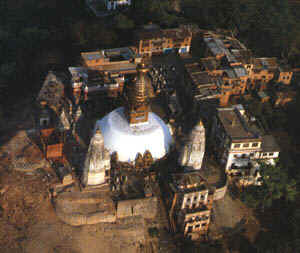
Balaju consists of a sprawling garden of stone water spouts, fish ponds, and a replica of the statue of Budhanilkantha. Situated below Nagarjun hill about 3 km northwest of the city center, Balaju is known for its bank of 22 stone water spouts (hiti) carved in the shape of sea-dragons during the 18th century. Devotees take ritual baths under the gush of water in Balaju, also known as Lhuti. This is also an ideal place for picnic and relaxation. There are many beautiful folk songs focused on the Balaju Water Garden. Next to the garden is an Olympic sized swimming pool open to the public.
Budhanilkantha is situated below Shivapuri hill at the northern end of the Valley. It is about 9 km from the city center. The hub of the temple complex is a pond in which lies a 5 meter (17 feet) long great stone figure of Hindu god Bishnu reclining on the coils of a cosmic serpent. The figure has been estimated to have been found buried in the ground in its original state more than thousand years ago. It is also known as Bhuijasi. Hindus throng to this sacred pilgrimage almost everyday to perform puja but a great number of worshippers can be seen in various festivals, especially on Haribodhini Ekadashi that falls between October/November, the day believed that the sleeping Lord Bishnu wakes up.
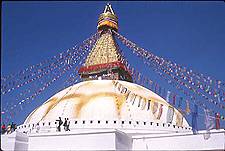 Bouddhanath Stupa lies about 6 km east of downtown Kathmandu and is the largest stupa in the Valley and one of the largest in the world. It looms 36 meters high and presents one of the most fascinating specimens of stupa design with hundreds of prayer wheels and 108 small images of Buddha all around. Just like the Swayambhunath, the stupa here is too has four sides with the watchful eyes of Lord Buddha. All the Buddhist throng to this stupa to take part in the sacred rituals during the Buddhist festivals.
Bouddhanath Stupa lies about 6 km east of downtown Kathmandu and is the largest stupa in the Valley and one of the largest in the world. It looms 36 meters high and presents one of the most fascinating specimens of stupa design with hundreds of prayer wheels and 108 small images of Buddha all around. Just like the Swayambhunath, the stupa here is too has four sides with the watchful eyes of Lord Buddha. All the Buddhist throng to this stupa to take part in the sacred rituals during the Buddhist festivals.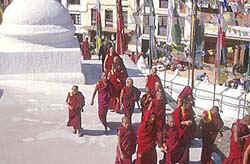 Bouddhanath, a World Heritage Site is also known as Khasti. There are more than 45 Buddhist monasteries in the area. Many have schools that teach young monks like those pictured here.
Bouddhanath, a World Heritage Site is also known as Khasti. There are more than 45 Buddhist monasteries in the area. Many have schools that teach young monks like those pictured here.An information counter, run by the Bouddha Area Preservation & Development Committee (Ph: 4471368) offers assistance to visitors.
Changu Narayan Temple is situated on a ridge overlooking the Valley, about 12 km to the east of the city. It is dedicated to the Hindu God Bishnu – the Preserver. One of the finest and oldest specimens of pagoda architecture, the temple is embellished with exquisite wood and stone carvings and is said to be the oldest pagoda style temple in Nepal built sometime back in 323 A.D. The sacred complex is a World Heritage Site and offers a panoramic view of the surrounding at 125 meters.
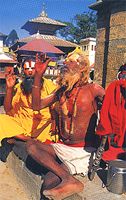 Pashupatinath Temple. One of the most sacred Hindu shrines in the world, Pashupatinath lies 5 km east from the city center. The richly-ornamented pagoda houses the sacred linga, or phallic symbol, of Lord Shiva as well as the noteworthy gold plated roofs and silver coated doors. This is the abode of God Shiva and is the holiest of all the Shiva shrines.
Pashupatinath Temple. One of the most sacred Hindu shrines in the world, Pashupatinath lies 5 km east from the city center. The richly-ornamented pagoda houses the sacred linga, or phallic symbol, of Lord Shiva as well as the noteworthy gold plated roofs and silver coated doors. This is the abode of God Shiva and is the holiest of all the Shiva shrines.Religious pilgrims and sadhus, like the one pictured here, travel all the way from the remote areas of India to visit this sacred sight, especially during Shivaratri (the night of Shiva) that falls between February/March. Even though these devotees have denounced worldly possessions, each carries a Sadhu ID (identifications card) to freely cross over the border between India and Nepal.
Chronicles indicate Pashupatinath’s existence prior to 400 AD. Devotees can be seen taking ritual dips in the holy Bagmati river flowing beside the temple, also a World Heritage Site. The crematorium is just outside the temple and it is a dream of almost every Hindu to be cremated by the side of Pashupati Aryaghat after their death.
Kirtipur, (population 40, 378 - 2001 Census) a small town is situated on a ridge 6 km southwest of Kathmandu. The ancient township established in 1099 is a natural fortress and has a proud and courageous history. It was the first place to be attacked by Prithvi Narayan Shah in 1768. The Chilamchu stupa and the temple of Bagh Bhairav are major sights here. Kirtipur offers quaint streets lined with artistic houses and temple squares and great views of Kathmandu Valley. The people are known for their skill in building and weaving and other ancient loom. The oldest educational institute, Tribhuvan University is located in the bottom of the hill.
Dakshinkali and Chobhar. The temple of Dakshinkali is dedicated to one of the most important Hindu Goddess Kali and is one of the most popular places of worship in Kathmandu. Located 22 km from the city center on the southern rim of the Valley past Pharping village, the shrine is especially crowded on Tuesdays and Saturdays when animal sacrifices are offered to the deity. On the way back, stop at Chobhar, the famous gorge, just 8 km south west of Kathmandu. The narrow gash in the hills was made by Lord Manjushree to drain out the lake which once covered the Valley. A majestic view of snow clad mountain can be viewed from the hilltop close by.
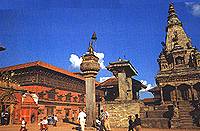 Durbar Square, like its counterpart in Kathmandu, is an enchanting mélange of palace buildings, artistic courtyards and graceful pagoda temples. Listed as a World Heritage Site, the former royal palace complex is the center of Patan’s religious and social life, and houses a museum containing an array of bronze statues and religious objects. There is an entrance fee of Rs. 200 per foreign visitor. One remarkable monument here is a 17th century temple dedicated to the Hindu God Krishna – Krishna Mandir built entirely of stone with rare stone carvings on its walls depicting the epic wars from Ramayana and Mahabharata.
Durbar Square, like its counterpart in Kathmandu, is an enchanting mélange of palace buildings, artistic courtyards and graceful pagoda temples. Listed as a World Heritage Site, the former royal palace complex is the center of Patan’s religious and social life, and houses a museum containing an array of bronze statues and religious objects. There is an entrance fee of Rs. 200 per foreign visitor. One remarkable monument here is a 17th century temple dedicated to the Hindu God Krishna – Krishna Mandir built entirely of stone with rare stone carvings on its walls depicting the epic wars from Ramayana and Mahabharata.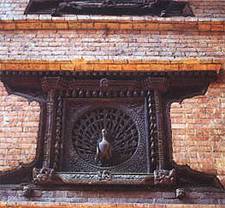
Iba Bahi is situated about a two-minute walk south of Durbar Square. It is one of the oldest Buddhist monasteries in Kathmandu Valley and reflects the sophisticated architecture of the Malla period. A two-step platform leads to the courtyard with a hall called Dalan. There is a shrine dedicated to Shakyamuni right across the entrance.
Kwa Bahal, also known as the Golden Temple, is a Buddhist monastery courtyard dating to the 12th century. It is a five-minute walk west and north from the northern end of Durbar Square. The monastery building is embellished with exceptionally fine wood-carvings and repousse work. Artistic images are scattered around the courtyard, and devotees can be seen offering worship at the many shrines here. Entrance fee
Rs. 25.
Rs. 25.
Mahabouddha can be reached by walking east from the southern end of Durbar Square and then turning right at the sunken water taps. This Buddhist monument is an excellent example of terra cotta art form which points to the skill of Patan’s ancient craftsmen with a variety of building styles. The 14th century monument’s obelisk-like design is also unusual in a city of pagoda roofs..
Oku Bahal is situated a few steps past Mahabouddha and is one of the best known Buddhist places of worship in Patan. The stone-paved courtyard is enclosed by a two-story building with gilded roofs. The wood-carvings on the roof struts are especially attractive. The place is peppered with sacred images and other small shrines.
Walkabout. Besides these much frequented tourist attractions, there are other ancient parts of Patan worth sight-seeing. Nakabahi, Nyakha Chuka, Nagbaha, Swotha Square, Tumbaha, Walkhu Tole, Chyasa, Kapinche, Chapat, Subaha, Bhinchhebaha, Dupat and Nugah make up a nice half-day walk around the squares, temples and monuments of inner Patan.
The Central Zoo in Jawalakhel is a pleasant diversion after a tour of the cultural sights. The only zoo in Nepal, wasfirst established in 1932 by a Rana Prime Minister as a private zoo and later opened to public in 1956. It houses about 106 species of birds and over 665 different animals and has 14 of the 38 endangered animals of Nepal. There is also a pond where you can go boating. The zoo is open daily except Mondays from 10 am to 5 pm. Entrance for foreign visitors costs Rs. 60 (Rs. 25 for children under 10). Elephant ride costs Rs. 100 (Tel: 5528324).
Tibetan Refugee Camp was set up in 1960 under the initiative of International Red Cross and the Swiss Development Corporation (SDC), known as Swiss Association for Technical Assistance (SATA) then, in cooperation with His Majesty’s Government of Nepal. Its main objective is to enable the Tibetan refugees to do something productive and support themselves. The carpet industry of Nepal is almost run by the Tibetan refugee families and the carpet factories have been a great source of employment for them to become self reliant economically. Apart from the carpet industry, Tibetan refugees are also engaged into handicrafts and there are many handicraft centers providing work opportunities to the families of the refugees with its profits going for the education, sanitation, healthcare of the Tibetans in the Refugee Camps including the physically handicapped and senior Tibetans.
 Durbar Square. As you walk in, you cannot but be overcome by a feeling of inner harmony. Such is the art and architecture and the special layout here. The Palace of 55 Windows built during the period of King Bhupatindra Malla in 1754 situated to the left as you enter through the city gate, inspires admiration. The National Art Gallery is also housed inside. The palace entrance, the Golden Gate known as Sunko Dhoka in Nepali is a masterpiece in repousse art. In front of the palace building is a medley of temples of various designs. Amongst the three Durbar Squares in the Valley, the Durbar Square in Bhaktapur is the best preserved one. There is an entrance fee of Rs. 30 for SAARC nationals and Rs. 500 for other foreign visitors.
Durbar Square. As you walk in, you cannot but be overcome by a feeling of inner harmony. Such is the art and architecture and the special layout here. The Palace of 55 Windows built during the period of King Bhupatindra Malla in 1754 situated to the left as you enter through the city gate, inspires admiration. The National Art Gallery is also housed inside. The palace entrance, the Golden Gate known as Sunko Dhoka in Nepali is a masterpiece in repousse art. In front of the palace building is a medley of temples of various designs. Amongst the three Durbar Squares in the Valley, the Durbar Square in Bhaktapur is the best preserved one. There is an entrance fee of Rs. 30 for SAARC nationals and Rs. 500 for other foreign visitors.Taumadhi Square lies to the east of Durbar Square reached by a narrow brick-paved lane. The towering five-roofed Nyatapol temple presides over the square. The monument gracefully soars into the sky atop a five-story plinth. The stairway leading up to the temple is flanked by stone figures of deities and mythical beasts, each 10 times more powerful than the one immediately below.
Dattatreya Square takes its name from the Dattatreya temple dedicated to a three-headed combination of the Hindu deities Brahma, Bishnu and Shiva. If you want to experience the feel of the traditional urban layout of Bhaktapur, Dattatreya Square is it. Set in a maze of streets lined with richly ornamented houses, the square is famed for its many ornate Hindu monasteries known as Math. The National Woodworking Museum is also housed here and the Brass and Bronze Museum is across the street. The oldest structure in Bhaktapur was raised during the reign of the last Malla King, Yaksha Malla who ruled the Valley before it was divided into three Kingdoms amongst his three heirs.
Potter’s Square. A two-minute walk south of Durbar Square brings you to Bolachhen, also known as Potter’s Square because of the many potters seen here moulding wet clay into different kinds of earthen ware. It has a display of fresh pottery left out to dry in the open square. This place can be approached from Taumadhi Square. The elephant-headed Lord Ganesh is the patron of potters, thus the Jeth Ganesh temple in the square.
Siddha Pukhu, a pond dating back to the Lichhavi period, is better known as Ta-Pukhu, meaning big pond. Though situated right at the bus stop, it provides a serene atmosphere with its sashaying fish and the stone images of different Hindu and Buddhist Gods.
Surya Binayak is one of Kathmandu’s most popular pilgrimage spots, 12 kilometers east of the center. It has been positioned in such a way to catch the first rays of the sun in the morning. Situated in a thick forest to the south of Bhaktapur, it is a 20-minute walk from the trolley bus terminal. The temple, dedicated to the Hindu deity Ganesh (the Elephant headed God) is crowded with devotees especially on Tuesdays and Saturdays. It is also one of the favorite picnic spots offering elegant views of Bhaktapur and other attractive landscapes.
Thimi
Thimi (population 48,000) is a farming town situated 8 km east of Kathmandu on the way to Bhaktapur. Exquisite temples and other religious shrines dot its streets. It is known for its artistic masks and earthen pots, often seen spread out on the streets to dry in the sun. It can be called a traditional pottery locality with almost 80% of the population still involved in pottery. Handspun cotton cloth is another Thimi specialty.
Suggested Half-Day Itineraries
Sight-seeing can be done on foot in the city core areas; for outlying spots, hire a car or take the bus. Travel agencies in Kathmandu offer a variety of half-day and full-day guided tours. The following combinations of tourist sites make for a pleasant half-day of sight-seeing:
Kathmandu Durbar Square and Swayambhu
Kathmandu and Patan Durbar Squares
Kathmandu Durbar Square and Pashupatinath
Pashupatinath, Bouddhanath and Bhaktapur Durbar Square
Pashupatinath, Bouddhanath, Changu Narayan
Balaju and Budhanilkantha
Kirtipur, Chobhar and Dakshinkali























































 T
T



Discussions